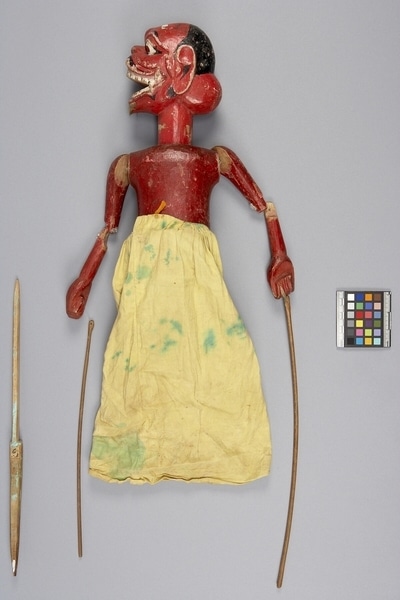Rod Puppet Item Number: Ib354 from the MOA: University of British Columbia


Description
A three-dimensional male humanoid figure puppet. Has a large head and jointed arms attached to controlling rods. Stick attached to the hand to the right with synthetic cord. The red face and irises are positioned upwards with the mouth open to reveal prominent upper and lower teeth. There are fangs from the top row at each side of the mouth with overlapping fangs directed up from the bottom. There is a black moustache with other facial details also in black. Black hair (skull cap ?) and prominent bulge from the rear base of the skull. Heavy set torso with a large belly. Wearing a yellow skirt.
History Of Use
Javanese puppetry as an art form probably developed by the 11th century. Wayang golek puppets of western Java appeared during the 16th century. Originally the plays depicted Javanese mythology, but after the Indian conquest of Java the Hindu epics, Ramayana and Mahabharata, were incorporated into the cycles, which comprise about 200 plays. A dalang (puppet master) performs the plays to celebrate important occasions, usually in three acts, with vocal and instrumental accompaniment. Typically they serve a moral and religious purpose, and more recently, one of political commentary. Demons and ogres are allied with the major antagonists in the plays; they serve to hinder the protagonist's progress in his quest or purpose. Ogres are an indigenous addition to the Javanese plays. This character might portray an undistinguished ogre or demon in a very minor role, such as a member of a crowd scene or as a servant.
Cultural Context
Theatrical performance.
Iconographic Meaning
Each puppet is characterized by it's wanda, a Javanese word which describes the specific mixture of elements of size, form, colour, ornamentation and carving. Red face and irises negative features, implying aggressiveness. Position of face and eyes indicate irreverence or spiritual contrariness. Large, grotesque features are not refined. Double fangs usually found on ogres (rakshasa). Garments are not rich or indicative of role. Bare chest implies character is not of human ancestry. Bump at rear of head may be representation of hair or a malformation. Character not identified; appears to be an ogre or demon (buta), although it is not distinguished in any way.
Item History
- Made in Java, Indonesia
- Owned by Tradewind Antiques before March 15, 1983
- Received from Museum of Anthropology Shop Volunteers (Funding source) and Tradewind Antiques (Seller) on March 15, 1983
What
Who
- Culture
- Sundanese
- Previous Owner
- Tradewind Antiques
- Received from
- Museum of Anthropology Shop Volunteers (Funding source) and Tradewind Antiques (Seller)
Where
- Holding Institution
- MOA: University of British Columbia
- Made in
- Java, Indonesia
When
- Ownership Date
- before March 15, 1983
- Acquisition Date
- on March 15, 1983
Other
- Condition
- poor
- Accession Number
- 0886/0088